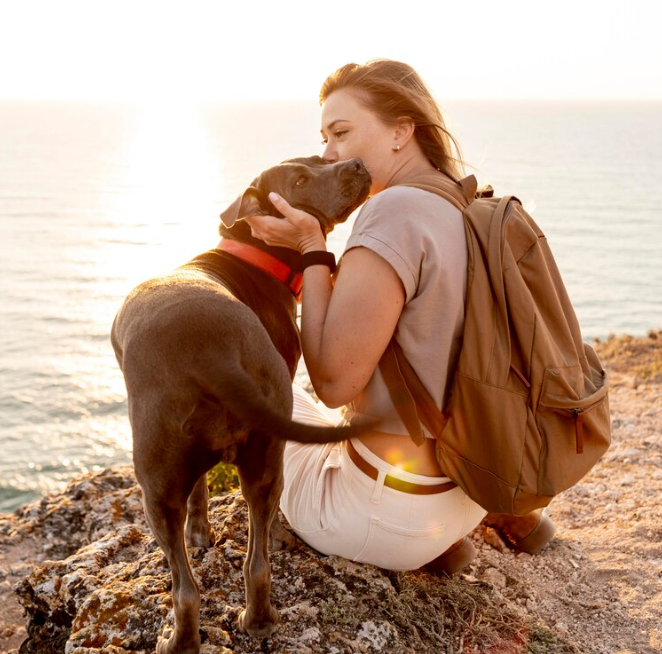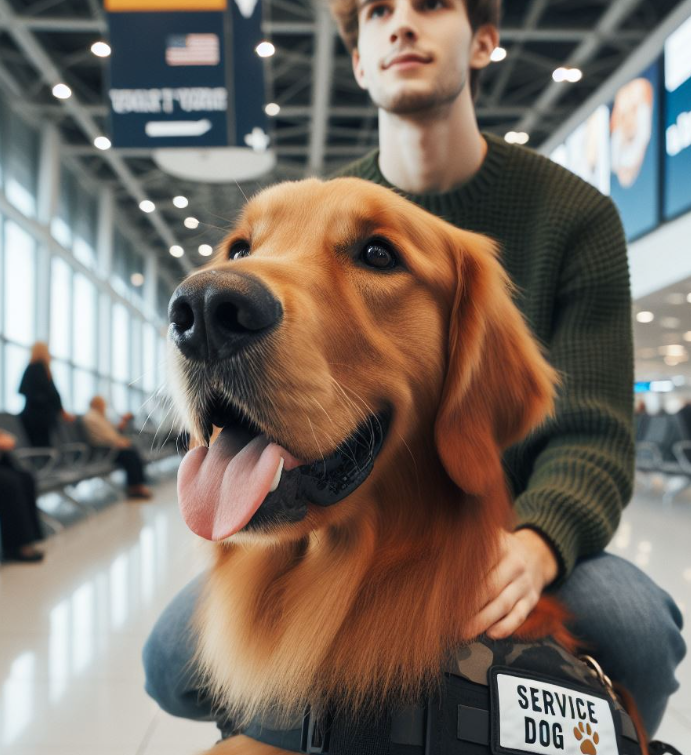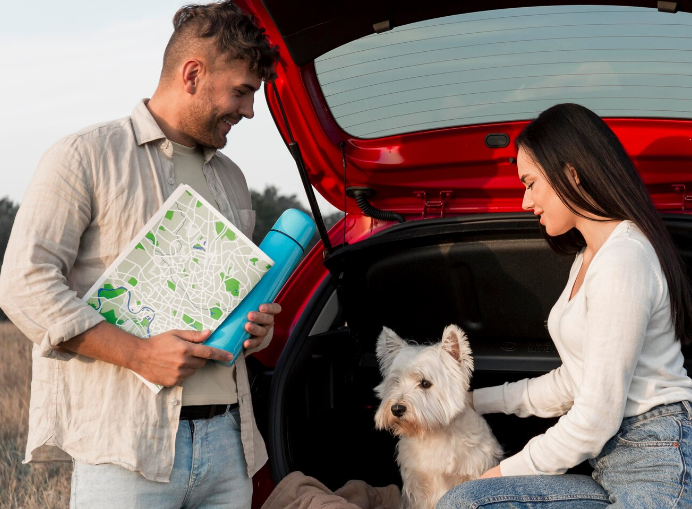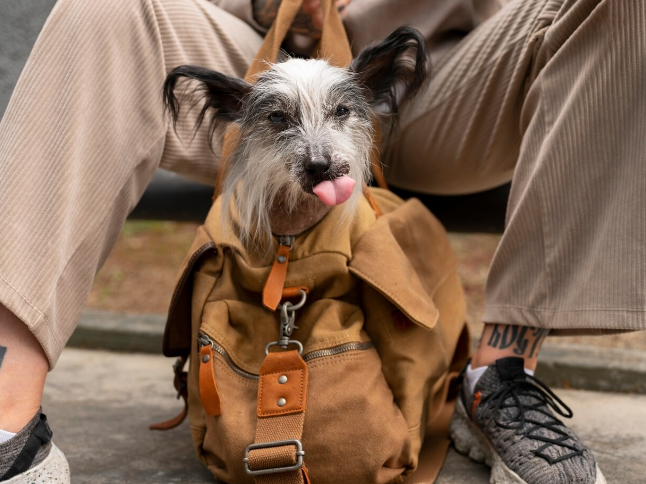
Summer is approaching! For many people, the season is associated with fun adventures, wonderful trips and unforgettable experiences!
Whether it is for relaxation, fun, or sometimes as part of the job, travel is a vital part of many people’s lives. While its positive aspects are undeniable, preparation for travel often causes stress and anxiety in most individuals. And if you intend to travel internationally with your dog, who is not just a pet, but a trained service animal, the process can become truly overwhelming!
This is mainly due to the various regulations and a bunch of documentation and requirements service dog teams have to meet.
The main goal of today’s article is to provide you with a list of tips on the most essential requirements that you and your service dog will likely have to comply with to travel internationally.
Before we begin, it is crucial to clarify that “traveling internationally” has a different meaning depending on where you reside and what country, region, state, or province you are traveling to. Regulations may be different, so make sure to familiarize yourself with them in advance.

Are Service Dogs Allowed to Fly in the Passenger Cabin?
It is essential to clarify, that unlike companion animals, service dogs are not treated as pets. Since they are individually trained to do specific work for the benefit of a person with a disability, they are permitted in the plane’s passenger cabin. They are allowed to remain in the footprint in front of the handler’s seat.
Of course, it is important to note, that they do not have to obstruct access to the aisle or emergency exit and are not allowed to occupy a seat.
While service dogs are allowed to accompany their owners in public, including on the plane, there are specific requirements they have to fulfill to be entitled to access.
Service Dogs Requirements for International Travel
Vaccination Records
Rabies vaccination is typically the most crucial requirement for international travel when it comes to the animal’s health.
Most countries require proof of rabies vaccination, administered within a certain time frame before travel. This usually ranges from 21 days to 12 months, depending on the country. In some cases, the vaccination against rabies may be valid for 4 years. Make sure to check its validity before travel.
The vaccination certificate usually includes the following information:
-Dog’s information such as their breed, age, weight, etc.;
-Microchip number;
-Vaccination date and expiration;
-Veterinarian’s signature and contact information.
Based on the country of destination, administration of additional vaccinations may also be needed, e.g. against distemper or parvovirus. We would highly recommend that you check the specific requirements of the country you are traveling to.
Tapeworm Treatment
Parasite control, particularly for tapeworms, is an important aspect of international travel with dogs, whether pets or service animals.
Some countries, especially those with strict measures, require dogs to undergo tapeworm treatment before entry. This aims to prevent the spread of tapeworms, which can be harmful to livestock and wildlife.
Based on the specific requirements in the destination country, the treatment may need to be administered no less than 24 hours and no more than 120 hours before your arrival.
Pet Passport
A pet passport is mainly used for traveling within the EU and certain other regions that recognize this document. It serves as a record of a pet's health, vaccinations, and treatments, making it easier to travel between countries without the need for additional documentation.
Usually, pet passports are valid as long as the rabies vaccination is up-to-date. They are continually updated with each vaccination or treatment.
Let’s add a quick note here- after Brexit, regulations for pet travel have changed. Please note that if your dog has a pet passport issued in the UK, it is no longer valid for entry into the EU.
Health Certificate
While they may sound almost identical, a pet passport and a health certificate are different types of documents.
A veterinary health certificate is often required by both airlines and airport agents at the country of destination. This certificate confirms that the dog is healthy and fit for travel. The requirements for the health certificate may vary depending on the destination country, but generally include:
-Examination date (within a specified time frame before travel);
-Confirmation of rabies vaccination;
-Microchip information;
-Absence of contagious diseases;
-Veterinarian’s signature and contact information.
A health certificate is typically required for international travel outside of regions that recognize the pet passport, including travel to and from the US. It serves as proof that a pet is healthy and free from contagious diseases at the time of travel. This document is often a prerequisite for entry into many countries and is used to meet the specific import requirements of the country of destination.
Unlike pet passports, health certificates are typically valid for a short period, often between 10 days to a few months, depending on the specific requirements. They must be issued shortly before travel to ensure that the dog is healthy and allowed onboard.

Microchip
Many countries require service dogs to be microchipped for identification purposes. It is important to ensure your dog's microchip complies with the ISO standard 11784/11785, which is widely accepted internationally.
If your dog's microchip does not meet this standard, you may need to have them implanted with a new microchip. While uncommon, the existing microchip may break or become unreadable, which also will necessitate a replacement.
Import Permits & Additional Documentation
When traveling with a dog, whether a pet or a service dog, never forget to check the necessary import permits in the country of destination.
For example, for dogs coming from high-risk countries for rabies, a Dog Import Permit issued by the Centers for Disease Control and Prevention in the US may also be required.
Some countries have specific import permit requirements for service dogs. These may involve additional documentation, fees, and waiting periods. It is recommended that you research on the entry requirements of your destination country in advance.
Also, it is important to note that based on the country you are traveling from, some restrictions may apply. Make sure to check these as well.
Along with the import permit, you may need to provide additional documentation, depending on the destination country, e.g. proof of tapeworm treatment and blood tests for certain diseases.
Quarantine Laws
Depending on the country of destination, your dog may be put under quarantine. For example, Australia has strict quarantine requirements. Your dog must undergo pre-arrival treatments, blood tests, and a minimum of 10 days in quarantine upon arrival.
Identification and Certification
While laws in many countries do not specifically require service dogs to wear identification gear or be certified, regulations may vary significantly between your departure and arrival locations.
Based on local laws and the policy of the airline for the specific itinerary, your dog may need to wear identification gear and have a certificate as proof of training.
In some cases, you may be allowed to train your dog yourself and/or benefit from training programs to ensure they are properly trained.
In other cases, in-person training by an accredited local school/trainer may be needed.
It is essential to check whether service dogs must be trained through Assistance Dogs International (ADI) or the International Guide Dog Federation (IGDF), or training through other organizations and schools can also be accepted if it meets certain requirements.
Most members of ADI and IGDF are non-profit organizations or charities that provide their trained service dogs.

Medical Documentation
While laws in many countries prohibit business owners from requiring a medical letter, this documentation may be needed based on the airline’s policy and the type of service dog.
For example, if you have a Psychiatric Service Dog, you may be asked to present a medical letter, issued by a licensed mental health professional. The purpose of this documentation is to verify you are eligible for a service dog. It does not disclose personal information but proves that the licensed healthcare provider issuing the document is aware of your health condition and recommends a service dog as a part of your treatment.
Airline’s & Airport’s Policies
It is essential to familiarize yourself with the policy of the airline you will be using and check for any specific regulations that may apply at the airport of your destination country.
Many airlines differentiate between their policies for traveling with service dogs to/from the US and to/from other countries, so make sure to check these in advance. For example, you might check the information listed on the Lufthansa (one of the major European airlines) website here: https://www.lufthansa.com/us/en/assistenzhunde
Furthermore, it is crucial to contact the airline in advance (no later than 48 or 72 hours before the flight based on the airline) and inform its agents that you intend to travel with a service dog. They will provide you with specific information on the documents you need to submit.
Make sure, your service dog complies with the requirements of both the airline and the airport.
DOT Form (For Flights to/from the US)
The U.S. Department of Transportation Service Animal Air Transportation Form is a document required by airlines for flying with service dogs within the US and to/from the US.
It requires information about the animal’s health, training, and behavior.
The Air Carrier Access Act in the US prohibits discrimination against persons with a physical or mental impairment that substantially limits one or more major life activities. This includes preventing service dogs from boarding flights.
Information about the DOT form and a template that will help you learn how to fill it out can be found in our article How to Fill Up DOT Service Animal Air Transportation Form To Fly With Your Service Dog.
Relief Attestation Form (For Flights Longer than 8 Hours to/from the US)
A Relief Attestation Form is another document that is specifically required for travel to/from the US when the flight is longer than 8 hours.
Both, the DOT form and the Relief Attestation Form can be found on the websites of the airlines that operate flights within the US and to/from the US.
Training Gear
While service dogs in many countries are not required to wear identification gear, they must be on a leash/harness or otherwise tethered when in public, especially when at the airport.
Regardless of how vigorous training your paw friend may have undergone, all service dogs must be under control in public and be on a leash.

New Rules to Enter/Return to the US That Come Into Effect on August 1st
According to the Centers for Disease Control and Prevention, there are new rules applying to the dogs entering or returning to the US that come into effect on Aug 1st.
We will quote below a portion of the new rules that apply to all dogs:
"All dogs must:
- Be at least 6 months of age at time of entry or return to the United States.
- Have an implanted International Organization for Standardization (ISO)-compatible microchip. This must have been implanted prior to any required rabies vaccination. The microchip number must be documented on all required forms and in all accompanying veterinary records.
- Appear healthy upon arrival.
- Dogs may not enter the United States if they are carrying a disease contagious to people.
- Isolation of the dog, veterinary examination, and additional testing, at the importer’s expense, may be required to determine if the dog has a contagious disease and prevent spread if the dog does not appear healthy upon arrival.
- Have a CDC Dog Import Form receipt. This form should be filled out online ideally 2-10 days before arrival; however, it can also be completed right before travel (even in line at the border crossing) if you have internet access. If the information on the form changes before the dog arrives, you must submit a new form and indicate you are making changes to an existing form. All information, including port of entry where the dog is arriving, must be correct at time of arrival. This form requires you to upload a clear photograph of the dog showing its face and body. Dogs that will be less than one year of age at time of arrival should have the photograph taken within 10 days before arrival. There is no charge to importers for submitting this form.
- Have additional documentation which varies depending on where the dog has been in the 6 months before entering or returning to the United States, or if the dog has a current rabies vaccine administered in the United States.
We strongly encourage you to familiarize yourself with the new rules on the CDC website.

Helpful Tips for Traveling a Service Dog
Don’t Forget to Contact the Airline in Advance
As mentioned above, you need to contact the airline you will be using before departure. In most cases, reaching out to them at least 48 hours in advance is needed, while in some cases, they may require service dog handlers to contact them 72 hours before the flight.
Relief Areas
Many international airports provide designated relief areas for service animals.
Make sure to familiarize yourself with the locations in advance. This will be particularly helpful for long flights.
Security Checks
Service dogs undergo security checks at the airport, so it is important to ensure your dog is properly trained and socialized.
Service animals need to remain calm when being handled and patted down.
Seating
When on the plane, your service dog will need to remain in a sitting/lying position in the foot space under your seat. Having said that, they need to be able to fit that space and not obstruct access to the emergency exit or aisle.
If your dog is of a large breed, it is essential to communicate that to the airport agents. Based on the policy of the airline and the available capacity of the specific flight, you may be offered extra space, a bulkhead seat, or asked to pay for an additional seat.
Pee Pads/Diapers
If you consider taking your service dog on a long flight, make sure to prepare a pee pad/diaper. These supplies will help you avoid any incidents on the plane.
Comforting Items
If your paw friend is still experiencing some stress when traveling, preparing their favorite toys or a warm blanket/your clothing with your scent on it, may have a calming effect on them.
Arrival and Customs
Upon arrival, present all required documentation to customs agents (based on the country of destination). Be prepared for additional health checks or inspections based on the country’s regulations.
Traveling with a service dog internationally requires some serious planning and compliance with various regulations. While the process may be a bit challenging and time-consuming, as long as you take your time to prepare, there is nothing to worry about!













